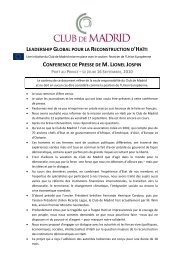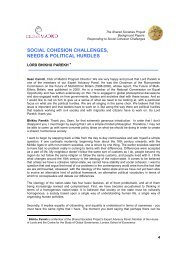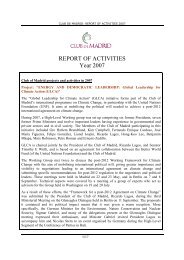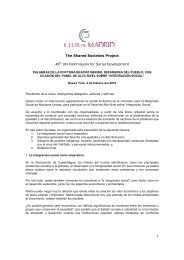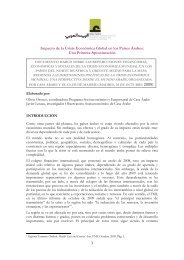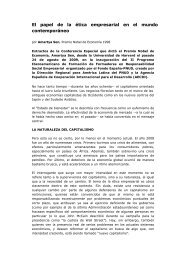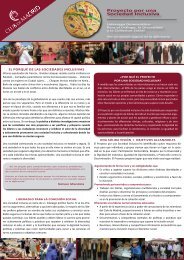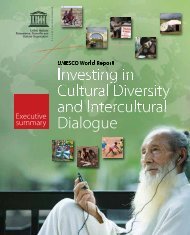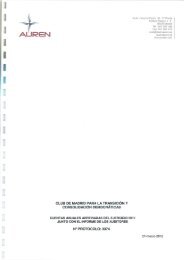Does Diversity Pay? - American Sociological Association
Does Diversity Pay? - American Sociological Association
Does Diversity Pay? - American Sociological Association
You also want an ePaper? Increase the reach of your titles
YUMPU automatically turns print PDFs into web optimized ePapers that Google loves.
<strong>Does</strong> <strong>Diversity</strong> <strong>Pay</strong>?: Race, Gender, and<br />
the Business Case for <strong>Diversity</strong><br />
Cedric Herring<br />
University of Illinois at Chicago<br />
The value-in-diversity perspective argues that a diverse workforce, relative to a<br />
homogeneous one, is generally beneficial for business, including but not limited to<br />
corporate profits and earnings. This is in contrast to other accounts that view diversity<br />
as either nonconsequential to business success or actually detrimental by creating<br />
conflict, undermining cohesion, and thus decreasing productivity. Using data from the<br />
1996 to 1997 National Organizations Survey, a national sample of for-profit business<br />
organizations, this article tests eight hypotheses derived from the value-in-diversity<br />
thesis. The results support seven of these hypotheses: racial diversity is associated with<br />
increased sales revenue, more customers, greater market share, and greater relative<br />
profits. Gender diversity is associated with increased sales revenue, more customers, and<br />
greater relative profits. I discuss the implications of these findings relative to alternative<br />
views of diversity in the workplace.<br />
Proponents of the value-in-diversity perspective<br />
often make the “business case for<br />
diversity” (e.g., Cox 1993). These scholars claim<br />
that “diversity pays” and represents a compelling<br />
interest—an interest that meets customers’<br />
needs, enriches one’s understanding of<br />
the pulse of the marketplace, and improves the<br />
quality of products and services offered (Cox<br />
1993; Cox and Beale 1997; Hubbard 2004;<br />
Richard 2000; Smedley, Butler, and Bristow<br />
2004). Moreover, diversity enriches the workplace<br />
by broadening employee perspectives,<br />
strengthening their teams, and offering greater<br />
resources for problem resolution (Cox 2001).<br />
The creative conflict that may emerge leads to<br />
Direct all correspondence to Cedric Herring,<br />
Department of Sociology (MC 312), University of<br />
Illinois at Chicago, 1007 W. Harrison, Chicago, IL<br />
60607 (Herring@uic.edu). I would like to thank<br />
William Bielby, John Sibley Butler, Sharon Collins,<br />
Paula England, Tyrone Forman, Hayward Derrick<br />
Horton, Loren Henderson, Robert Resek, Moshe<br />
Semyonov, Kevin Stainback, and the editors of ASR<br />
and the anonymous reviewers for their extraordinarily<br />
helpful comments and suggestions. An earlier<br />
version of this article was presented at the Annual<br />
Conference of the <strong>American</strong> <strong>Sociological</strong> <strong>Association</strong><br />
in Montreal, Canada in August 2006.<br />
closer examination of assumptions, a more complex<br />
learning environment, and, arguably, better<br />
solutions to workplace problems (Gurin,<br />
Nagda, and Lopez 2004). Because of such putative<br />
competitive advantages, companies increasingly<br />
rely on a heterogeneous workforce to<br />
increase their profits and earnings (Florida and<br />
Gates 2001, 2002; Ryan, Hawdon, and Branick<br />
2002; Williams and O’Reilly 1998).<br />
Critics of the diversity model, however, are<br />
skeptical about the extent to which these benefits<br />
are real (Rothman, Lipset, and Nevitte<br />
2003a, 2003b; Skerry 2002; Tsui, Egan, and<br />
O’Reilly 1992; Whitaker 1996). Scholars who<br />
see “diversity as process loss” argue that diversity<br />
incurs significant potential costs (Jehn,<br />
Northcraft, and Neale 1999; Pelled 1996; Pelled,<br />
Eisenhardt, and Xin 1999). Skerry (2002), for<br />
instance, points out that racial and ethnic diversity<br />
is linked with conflict, especially emotional<br />
conflict among co-workers. Tsui and<br />
colleagues (1992) concur, suggesting that diversity<br />
diminishes group cohesiveness and, as a<br />
result, employee absenteeism and turnover<br />
increase. Greater diversity may also be associated<br />
with lower quality because it can lead to<br />
positions being filled with unqualified workers<br />
(Rothman et al. 2003b; see also Williams and<br />
O’Reilly 1998). For these reasons, skeptics<br />
AMERICAN SOCIOLOGICAL REVIEW, 2009, VOL. 74 (April:208–224)



